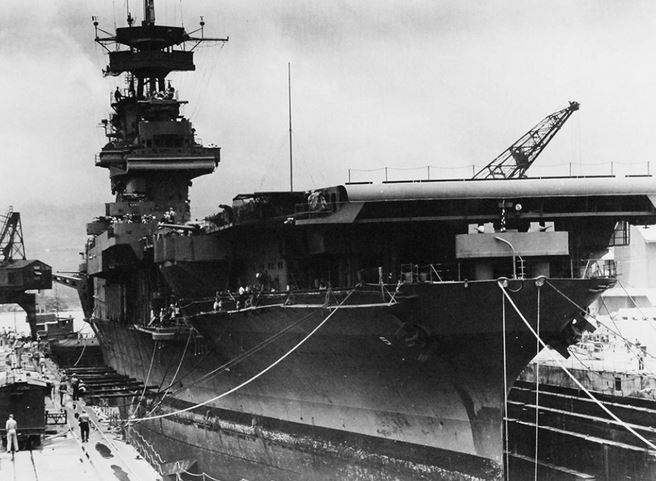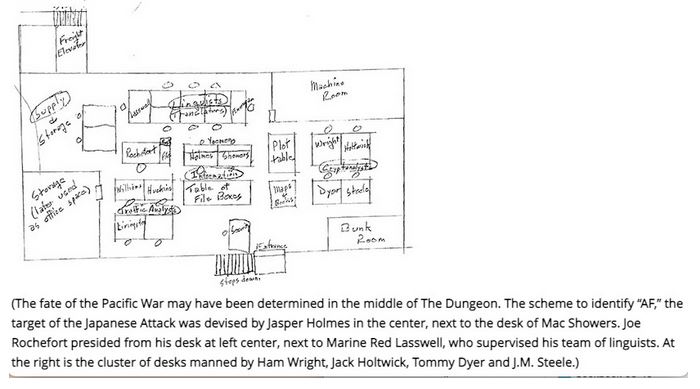Point Luck

(USS Yorktown in port Pearl Harbor, 29 May 1942 for combat repairs after the Battle of Coral Sea. The Shipyard had some timely orders to have her ready for sea in three days. Something big was in store. Photo USN).
There is plenty to talk about this morning. Plenty of stuff overseas as the Russian offensive in Ukraine seems to be teetering. There are lots of questions about leadership, material and morale on both sides of that recent conflict. We don’t have any answers at Refuge Farm in Virginia’s Piedmont as Spring finally seems to be erupting in a sea of green growth.
The Writer’s Section had only a short meeting about that, and the $40 Billion the Congress seems determined to send to the Ukrainian Government while an improbable shortage of infant formula exists right here. There is more, or course, but due to the partisan nature of the whole swirling crisis, our attorney has recommended taking about other May days that held questions, required sacrifice and had ‘Victory’ in the end.
We had a pal who was there for some of the most significant May days in American history. His time has passed, but he told us how it all happened over several years of companionship. Mac Showers had completed his counter-intelligence training in February of 1942. His class was divided in alphabetical order for follow-on orders. His group was assigned for duty at Pearl Harbor in the Territory of Hawaii.
He told us one afternoon at the Willow Bar in Arlington that it was just “dumb luck, alphabetical-style” that he was not assigned to the other ship headed for Cavite Point in the Philippines. From that ship, his classmates would disembark to be converted to prisoners of the Empire of Japan.
Instead, his half of the class arrived on Oahu in February, 1942. After some confusion as to what he would be assigned to do, he was selected to fill an obscure but important billet at the Naval Station, in the basement of the Naval District HQ. Commander Joe Rochefort had an important mission no one could talk about: Breaking the codes of the Imperial Navy, informing new Fleet Commander Chester Nimitz what the enemy intended to do, and help defeat them.
If you were a freshly-commissioned young Naval officer from Iowa, it would have been breathtaking. Mac described it in the unconventional history he described for us. The notion of “radio intelligence” was still a very sensitive matter. Communications were conducted by radio signals anyone could detect. The means of concealing what those obvious signals meant was the key to the problem. Rochefort’s little team of officers and sailors were the key to understanding what the enciphered radio signals actually said.
If this was the May that Mac and the others in the small basement office experienced, it would have featured a unique event in warfare. Last week, 80 years in the past, Mac was learning a new trade. A major battle had been fought in the Southwest Pacific in a watery place known as the Coral Sea. Admiral Nimitz had dispatched naval forces to turn back a Japanese invasion force headed for Port Moresby in New Guinea. The Japanese intent was to seize control of the waters between Australia and New Caledonia. The struggle that ensued was a desperate one, and marked the first encounter between fleets organized around aircraft carriers. The results were the loss of a small Japanese carrier, IJN Shohu and damage to another. The American lost USS Lexington with significant damage to USS Yorktown.
In terms of numbers, it was about a draw. But it was the first time the Japanese juggernaut was stymied in it’s previously inexorable advance. Rochefort’s team in The Dungeon had determined there was more to come, and the date only a few weeks away.
After the battle, Yorktown limped back to Pearl Harbor, arriving on 27 May. She had sustained multiple critical hits to her hull during the battle. Nimitz took a look, knowing what the Dungeon Team had told him was the Japanese plan of attack. He told the Shipyard: “You have 72 hours. Get her ready to sail.”
Over the next few days, 1,400 repairmen worked around the clock to complete the task. On the morning of 30 May, the patched-up ship steamed out of Pearl Harbor to rendezvous with carriers Enterprise and Hornet at “Point Luck” for a potential conflict off the small base at Midway Island. We at Willow were interested, of course, but in a different way than the historians. “So, when you guys came up with the plan to make the Japanese reveal their objective that convinced Nimitz to gamble it all, where did it happen in that little office?”
Mac smiled. The next time we met, he had a small plot of the desks drawn out in a neat rectangle. It happened to be at the corner of his desk where Jasper Holmes laid out the gambit. Mac had made the diagram of the basement office to help us understand how an event that would shape world history can sometimes happen next to your desk. If your desk is in the right place:

With the objective confirmed, Admiral Nimitz made his decision. There was controversy with Washington over the matter that went on for decades. But Chester Nimitz was going to throw everything he had at the problem as Joe Rochefort’s team had explained it.
So, we are having a month of May that has it’s challenges. But as for Midway Atoll, as they say, the rest is history.
Copyright 2022 Vic Socotra
www.vicsocotra.com
Editor’s Note: Interested in the whole story? Check “Cocktails With the Admiral” by Vic Socotra at the Politics and Prose website: https://www.politics-prose.com/
